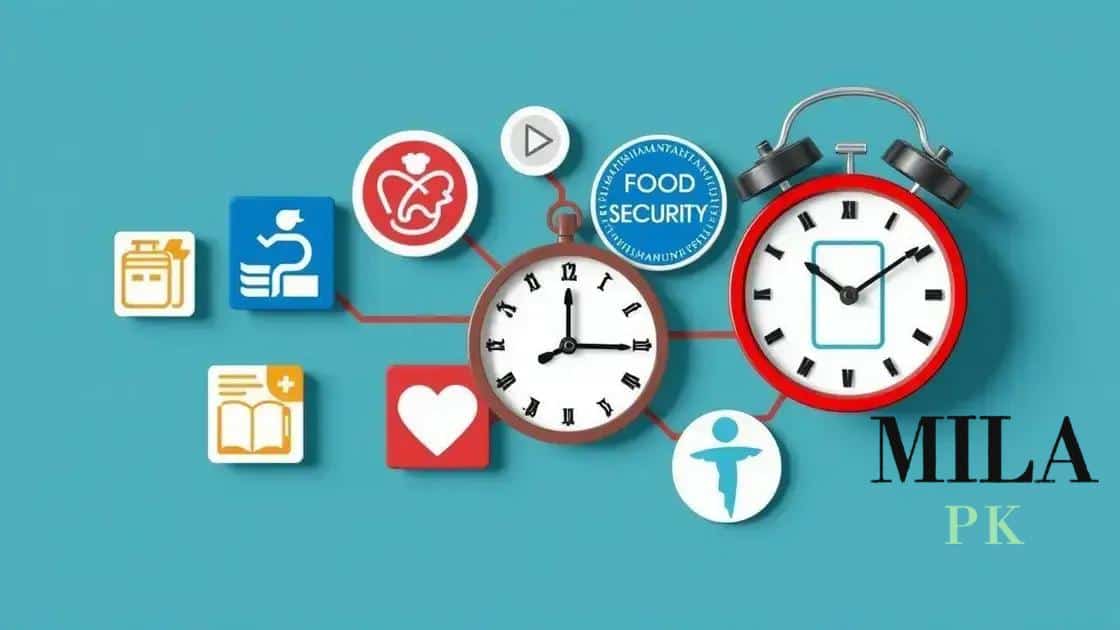Government shutdown puts benefit payments at risk

A Government shutdown puts benefit payments at risk, potentially delaying essential services such as Social Security, food assistance, and healthcare, necessitating proactive preparations from individuals and families.
Government shutdown puts benefit payments at risk, and for many people, this situation raises urgent concerns. Have you ever considered how these budget issues might affect your life and those around you? Let’s dive into the details.
Understanding the implications of a government shutdown
Understanding a government shutdown is crucial for many citizens, as it has far-reaching effects on various federal services and benefits. During these shutdowns, the government halts non-essential operations, which can impact individuals and families in profound ways.
What Happens During a Shutdown?
When the government shuts down, federal employees may be furloughed or required to work without pay. This disruption leads to delays in processing benefits and services that many rely on.
Key Impacts of a Government Shutdown
- Health Benefits: Programs like Medicaid and Medicare could face operational delays.
- Food Assistance: Distribution of benefits, such as SNAP, may slow down.
- Housing Support: Rent subsidies could be delayed, affecting low-income families.
- Job Services: Unemployment benefits processing might also be hindered.
The implications extend beyond just benefit payments. A government shutdown can lead to reduced public services and increased wait times for things like visa applications and federal loans. It’s essential for people to understand these potential issues and prepare accordingly.
Citizens may need to seek local resources or apply for state-level assistance while the federal government is not operational. It can also be challenging to navigate these circumstances, leaving individuals feeling uncertain about their support services.
It’s vital to stay informed about the status of the government shutdown, as changes can occur rapidly. Following trusted news sources can help individuals remain aware of the latest information and potential solutions.
Which benefits are at risk during a shutdown?

During a government shutdown, various benefits are at risk, creating uncertainty for many individuals and families. Understanding which benefits may be affected can help you prepare for potential disruptions.
Types of Benefits Affected
Several key programs face potential delays or interruptions. It is essential to know these to make necessary adjustments during a shutdown.
- Social Security: Payments might continue, but there could be delays in processing new applications.
- Food Assistance Programs: Programs like SNAP might see delays in fund distribution.
- Medicaid and Medicare: Service access might be restricted, impacting those relying on these healthcare programs.
- Unemployment Benefits: Processing new claims could slow down significantly.
The impact of a government shutdown extends beyond these programs. Many agencies that provide services or payments will either operate at reduced capacity or halt operations altogether. People may face longer wait times or the need to seek alternative assistance.
Local and state resources may step in to fill gaps when federal assistance is impacted. However, the availability of these resources can vary widely, making communication vital. For individuals relying on critical services, staying informed about the status of these programs is essential.
It’s important to create a plan that includes accessing alternative support options while awaiting federal services to resume. Understanding these risks can guide you in making informed decisions during uncertain times.
How to prepare for potential payment disruptions
Preparing for potential payment disruptions during a government shutdown is crucial. Many people depend on timely payments for their essential needs. Understanding how to navigate this situation can reduce stress and ensure your needs are met.
Understand Your Benefits
Knowing what benefits you receive is the first step. Make a list of all the programs you rely on, such as Social Security, SNAP, and Medicaid. This awareness will help you identify which payments may be at risk.
Build an Emergency Budget
An emergency budget can help manage finances if payments are delayed. Focus on essentials like food, housing, and healthcare. Here are some steps to consider:
- Monitor Expenses: Track your spending to see where you can cut back.
- Prioritize Needs: Make sure to allocate funds for vital expenses first.
- Save Where Possible: Try to set aside small amounts whenever feasible to build a cushion.
Having a financial plan in place can provide peace of mind during uncertain times. If you foresee possible disruptions, consider seeking additional sources of income or exploring local resources for assistance.
Staying informed about the status of the government and its operations is vital. Check news updates, government websites, and community resources regularly. Engaging with local community centers can help reveal available support options.
By preparing in advance, you can mitigate the impact of any disruptions. Having actionable steps will empower you to face challenges head-on, ensuring you are ready for any shifts in your financial situation.
Historical context: past government shutdowns and their impacts
Understanding the historical context of past government shutdowns can provide valuable insights into their effects. These shutdowns have occurred numerous times, each with unique causes and consequences that shape current policies.
Key Historical Shutdowns
Historically, shutdowns have often stemmed from disputes over budget allocations and policy disagreements between political parties. Some significant shutdowns include:
- 1995-1996 Shutdown: This lasted for 21 days, primarily due to conflicts over budget cuts. Many federal employees were furloughed, impacting services significantly.
- 2013 Shutdown: Lasting 16 days, this shutdown was centered around the implementation of the Affordable Care Act. Many agencies were temporarily closed, causing disruptions in public services.
- 2018-2019 Shutdown: The longest in U.S. history, lasting 35 days, it arose from a dispute over funding for a border wall. This shutdown affected millions and delayed many important services.
The impacts of these past shutdowns varied widely. Each time, the government experienced interruptions in services like visa processing, health programs, and federal payments. Additionally, businesses that rely on government contracts often faced revenue loss.
During these periods, public sentiment typically shifts, leading to increased demand for accountability and changes in future budget discussions. Surveys often show that shutdowns can negatively affect voter perceptions of government effectiveness.
These historical events serve as reminders of the potential consequences of political stalemates. They highlight the need for effective communication among lawmakers to prevent future disruptions and ensure essential services remain uninterrupted.
What can be done to mitigate the risks?
To mitigate the risks associated with a government shutdown, individuals and families can take proactive steps. These measures can help ensure stability during uncertain times.
Stay Informed
Keeping track of news related to the government is essential. Regularly check reputable news sources and official government websites for updates. Awareness of potential shutdowns can help you prepare in advance.
Assess Your Financial Situation
Review your current financial status. Understanding your savings and monthly expenses is vital in case of payment disruptions. Consider the following:
- Emergency Fund: Build a savings buffer for unexpected expenses.
- Monthly Budget: Create a budget that prioritizes essential needs.
- Cut Non-Essential Spending: Identify areas where you can minimize expenses.
By assessing your finances, you can create a clearer picture of how a shutdown might affect you.
Apart from financial planning, exploring additional resources can also be beneficial. Community organizations often provide support services, from food banks to counseling. Connecting with local services can ease the pressure during tough times.
If you rely on federal services, having contingency plans in place can also help. Look into state or local programs that might offer similar benefits. Additionally, considering temporary work options could provide an alternative source of income if federal benefits are interrupted.
By taking these steps, you can better position yourself to handle the impacts of a government shutdown and mitigate risks associated with payment disruptions.
In summary, understanding the risks associated with a government shutdown is essential for everyone. Taking proactive steps like staying informed, evaluating your financial situation, and seeking community support can lessen the impacts of a shutdown. By preparing in advance, you can navigate these challenges more effectively and minimize disruptions to your daily life.
FAQ – Frequently Asked Questions About Government Shutdowns
What is a government shutdown?
A government shutdown occurs when Congress fails to pass funding bills, leading to a halt in non-essential government services and operations.
How does a government shutdown affect federal benefits?
During a government shutdown, many federal benefits, such as Social Security and food assistance programs, may experience delays or interruptions in processing.
What should I do to prepare for a potential government shutdown?
To prepare, stay informed about news updates, assess your financial situation, and create an emergency budget to manage your expenses.
Where can I find support during a government shutdown?
You can seek help from local community organizations and state programs that provide assistance for food, healthcare, and other essential services during tough times.





